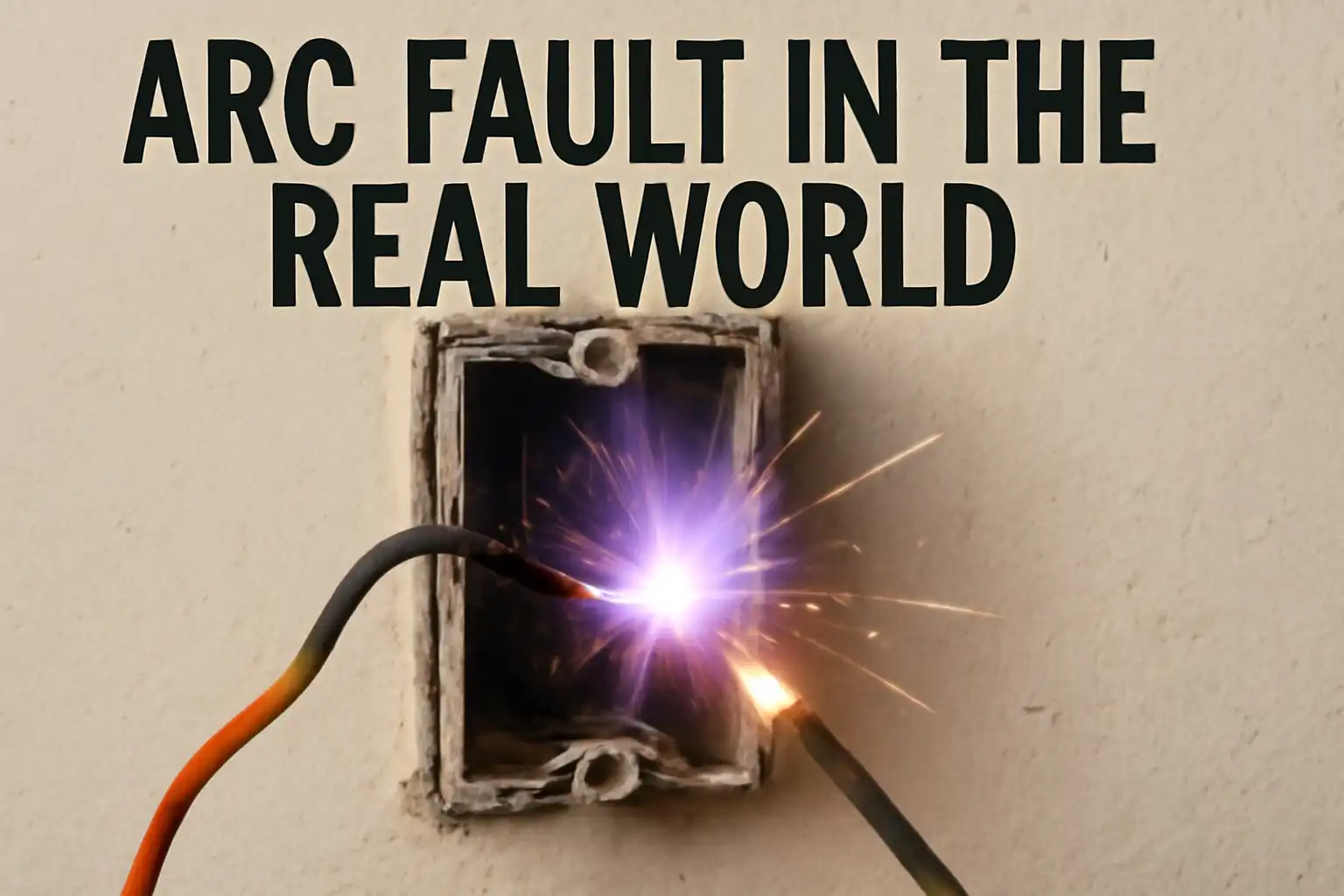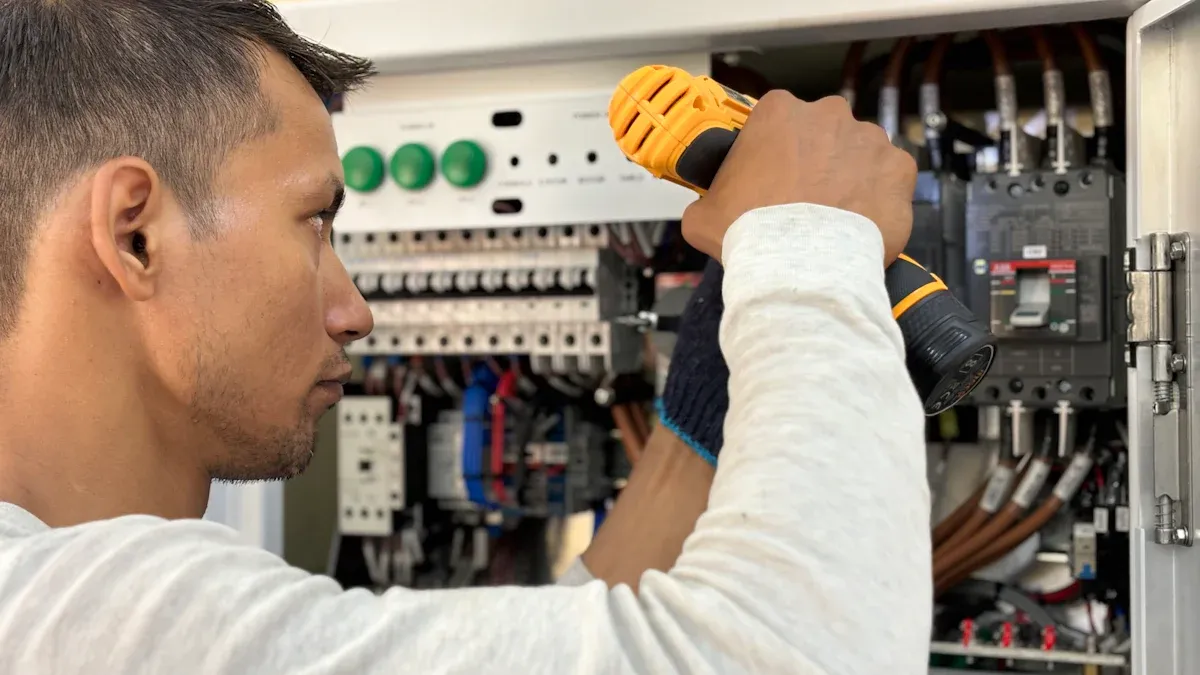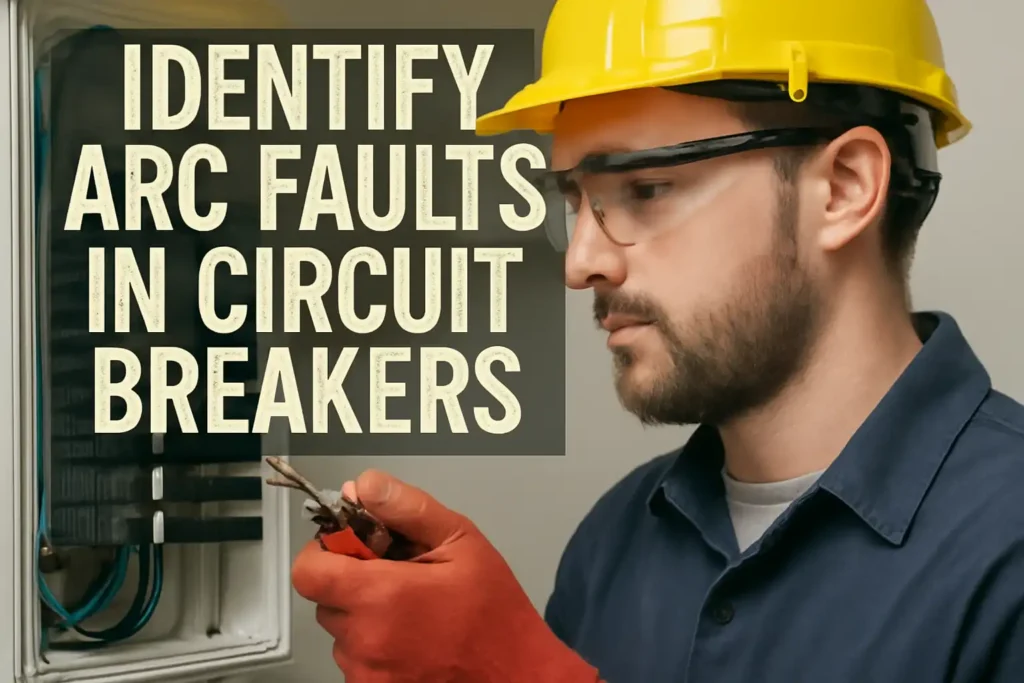You can spot an arc fault in your circuit breaker by looking for clear warning signs. Always use the TEST button on your AFCI breaker to check for problems. Watch out for these signs:
- Frequent tripping of the breaker
- Burning smell near the panel
- Buzzing or crackling sounds
Quick action keeps your home safe. If you notice these issues, act right away to prevent electrical hazards.
Key Takeaways
- Arc faults happen when electricity jumps between wires, causing sparks that can start fires.
- Watch for signs like frequent breaker trips, burning smells, buzzing sounds, and scorch marks near outlets.
- Use the TEST button on AFCI breakers monthly to make sure they work and protect your home.
- If you notice problems, turn off the breaker, unplug devices, and call a licensed electrician for help.
- Regular checks and upgrading to AFCI breakers help prevent arc faults and keep your family safe.
What Is an Arc Fault?
Arc Fault Basics
You may wonder what an arc fault is and why it matters for your home. An arc fault happens when electricity jumps from one wire to another or to the ground. This jump creates a spark or “arc.” You can think of it as a mini lightning bolt inside your walls or outlets. These arcs can get very hot. They can burn through wires and even start fires.
You might see an arc fault if a wire gets damaged or worn out. Sometimes, a loose connection in an outlet or switch can cause it. Even a nail or screw that hits a wire behind the wall can lead to an arc fault. You do not always see the damage, but the risk is real.
Tip: If you hear a crackling sound or smell something burning near an outlet, you should check for an arc fault right away.
Why Arc Faults Matter
Arc faults are a big deal because they can cause house fires. Many home fires start because of faulty wiring or damaged cords. When an arc fault happens, it can heat up nearby materials like wood or insulation. This heat can start a fire before you even notice a problem.
You want to keep your family and home safe. That is why you need to spot arc faults early. Modern homes use special breakers called AFCIs (Arc Fault Circuit Interrupters). These breakers shut off power when they detect an arc fault. You should test these breakers often to make sure they work.
Here is a quick list of why you should care about arc faults:
- They can cause fires.
- They may damage your electrical system.
- They put your safety at risk.
Knowing how to find and fix an arc fault helps you protect your home.
Arc Fault Signs

Frequent Tripping
You may notice your circuit breaker trips often. This is one of the first signs of a problem. If you reset the breaker and it trips again soon after, you should pay attention. Frequent tripping can mean you have an arc fault in your wiring or devices. Do not ignore this warning. Each time the breaker trips, it tries to protect your home from danger.
Tip: Write down when and how often your breaker trips. This record helps you or an electrician find the cause faster.
Burning Smell or Scorch Marks
A burning smell near your electrical panel or outlets is a serious warning. You might also see dark marks or discoloration around outlets or switches. These signs mean heat is building up where it should not. An arc fault can cause wires to overheat and burn. If you smell burning or see scorch marks, turn off the power to that area right away.
- Check outlets and switches for:
- Black or brown marks
- Melted plastic
- Unusual warmth
Buzzing or Crackling
Listen for strange sounds near your breaker panel or outlets. Buzzing, crackling, or sizzling noises can mean electricity is jumping between wires. This is not normal. These sounds often point to a loose connection or damaged wire. You should act quickly if you hear these noises.
Note: Sounds may come and go. Try to listen at different times of day.
Power Loss at Outlets
Sometimes, you may lose power at one or more outlets. If you plug in a device and it does not work, check other outlets on the same circuit. Power loss can happen when a breaker trips due to an arc fault. It can also mean a wire has burned through. Always check for other signs before turning the breaker back on.
Check for Arc Faults

Visual Inspection
Start by looking at your electrical panel, outlets, and switches. Use a flashlight if you need more light. Check for any signs of damage. Look for black or brown marks, melted plastic, or wires that look loose. If you see anything that looks burned or out of place, do not touch it. Turn off the power to that area right away.
Tip: Always keep your hands dry and stand on a dry surface when you inspect electrical parts.
You can also check the cords and plugs of your devices. If you see frayed wires or broken plugs, unplug them and replace them. Damaged cords can cause problems and may lead to an arc fault.
Listen for Noises
Stand near your breaker panel and outlets. Listen for buzzing, crackling, or sizzling sounds. These noises can mean that electricity is jumping between wires. If you hear these sounds, you may have a loose connection or a damaged wire.
Try to listen at different times of the day. Sometimes, the noise only happens when certain devices are on. If you hear strange sounds, turn off the breaker and call a professional.
Note: Never ignore unusual sounds from your electrical system.
Use the TEST Button
If your home has AFCI breakers, you can use the TEST button to check for problems. The TEST button helps you make sure the breaker works as it should. Follow these steps:
- Find the AFCI breaker in your electrical panel. It usually has a label that says “AFCI” and a small TEST button.
- Press the TEST button firmly. You should hear a click, and the breaker handle should move to the “off” position.
- If the breaker trips, it means the AFCI is working. Reset the breaker by moving the handle to “off” and then back to “on.”
- If the breaker does not trip when you press the TEST button, the AFCI may not work. You should call an electrician to check it.
Alert: Only use the TEST button on AFCI breakers. GFCI breakers also have a TEST button, but they protect against different problems like ground faults.
Isolate the Source
If your breaker keeps tripping, you can find the cause by unplugging devices. Here is how you do it:
- Turn off the breaker that keeps tripping.
- Unplug all devices and lamps from the outlets on that circuit.
- Turn the breaker back on.
- Plug in one device at a time. Wait a few minutes after each one.
- If the breaker trips after you plug in a certain device, that device may have a problem.
- If the breaker trips with no devices plugged in, the wiring may have an issue.
This method helps you find out if the problem comes from a device or from the wiring.
Tip: Write down which devices you test and what happens. This record helps you and your electrician.
AFCI vs. GFCI: What’s the Difference?
AFCI stands for Arc Fault Circuit Interrupter. It protects your home from fires caused by arc faults. GFCI stands for Ground Fault Circuit Interrupter. It protects you from electric shock near water, like in bathrooms or kitchens.
- Use the TEST button on AFCI breakers to check for arc faults.
- Use the TEST button on GFCI breakers to check for ground faults.
Both types of breakers help keep your home safe, but they protect against different dangers.
When to Use a Circuit Breaker Tester or Multimeter
If you still cannot find the problem, you can use a circuit breaker tester or a multimeter. These tools help you check if the breaker works and if the outlets have power.
- A circuit breaker tester plugs into an outlet and shows if the wiring is correct.
- A multimeter measures voltage and can help you find broken wires.
If you do not know how to use these tools, ask a professional for help. Using them the wrong way can be dangerous.
Safety Reminder: Never open the electrical panel or touch wires unless you know what you are doing.
What to Do Next
Safety Steps
If you suspect an arc fault, you need to act quickly to keep your home safe. Start by turning off the affected breaker. This step stops the flow of electricity and lowers the risk of fire or shock. Always use dry hands and stand on a dry surface when you touch your electrical panel.
Follow these steps for safety:
- Turn off the breaker that keeps tripping.
- Unplug all devices from outlets on that circuit.
- Check for any signs of heat, burning, or damage.
- Keep children and pets away from the area.
Tip: If you see smoke or flames, leave your home right away and call 911.
Call a Professional
Some electrical problems need expert help. If you cannot find the cause of the arc fault, or if the breaker will not reset, you should call a licensed electrician. Electricians have the right tools and training to fix wiring safely.
You should also call a professional if:
- You see scorch marks or melted wires.
- You smell burning even after turning off the breaker.
- The breaker trips with nothing plugged in.
- You feel unsure about any step.
Note: Never try to repair wiring inside the walls by yourself.
Do’s and Don’ts
You can protect your home by following these simple rules:
| ✅ Do’s | ❌ Don’ts |
|---|---|
| Use the TEST button on AFCI breakers each month | Ignore frequent breaker trips |
| Unplug devices before checking outlets | Use damaged cords or plugs |
| Call a professional for wiring issues | Try to fix hidden wires yourself |
| Keep a record of electrical problems | Overload outlets with too many devices |
Stay alert to warning signs. Quick action and smart choices help you keep your home and family safe.
Prevent Arc Faults
Regular Checks
You can stop many electrical problems by checking your home often. Look at your outlets and switches every month for damage. Check for scorch marks or covers that are loose. Test your AFCI breakers by pressing the TEST button. Listen for buzzing or crackling near outlets. If you find anything strange, turn off the breaker and call an electrician.
Tip: Set a phone reminder to check your electrical panel each month. Regular checks help you find problems before they get dangerous.
Upgrade to AFCI
Older homes might not have AFCI breakers. You can make your home safer by upgrading your electrical panel. AFCI breakers find arc faults and shut off power before a fire starts. Ask a licensed electrician to put AFCI breakers in bedrooms, living rooms, and other important places. This upgrade keeps your home safe from hidden wiring problems.
- Benefits of AFCI breakers:
- Find dangerous arcs
- Lower fire risk
- Meet new safety rules
Alert: Only a professional should put in or change circuit breakers.
Safe Practices
You can lower the chance of electrical fires by using safe habits every day. Plug only one high-watt device into each outlet. Replace cords that are damaged right away. Never run cords under rugs or furniture. Keep liquids away from outlets and plugs. Teach your family about electrical safety.
| Safe Practice | Why It Matters |
|---|---|
| Unplug unused devices | Stops overheating |
| Use surge protectors | Guards against spikes |
| Keep outlets covered | Protects small children |
Watch for warning signs. Quick action and safe habits help you stay away from arc fault dangers.
You can help keep your home safe by finding electrical problems early. Press the TEST button on your AFCI breakers every month. Watch for burning smells or buzzing sounds around outlets. If you see damage or feel unsure, call a licensed electrician for help. Always pay attention and act fast to protect your family. Make checking for electrical safety something you do often.
FAQ
What should you do if your AFCI breaker will not reset?
If your AFCI breaker will not reset, unplug all devices on that circuit. Try to reset the breaker again. If it still trips, you may have a wiring problem. You should call a licensed electrician for help.
How often should you test your AFCI breakers?
You should press the TEST button on your AFCI breakers once a month. This quick check helps you make sure the breaker works and keeps your home safe.
Tip: Set a reminder on your phone so you do not forget.
Can you replace an AFCI breaker yourself?
You should not replace an AFCI breaker by yourself. Only a licensed electrician should do this job. Working inside the electrical panel can be dangerous if you do not have the right training.
What is the difference between an arc fault and a ground fault?
An arc fault happens when electricity jumps between wires and creates heat or sparks. A ground fault happens when electricity escapes to the ground, often near water. AFCI breakers protect against arc faults. GFCI breakers protect against ground faults.
See also
How to Identify the Type of Circuit Breaker in Your Home
Why Room Circuit Breaker Choice Matters for Your Safety
What Is an Arc in a Circuit Breaker and Why Does It Matter
Learn How to Install and Test RCCBs Safely
How to safely check the faults of RCCB



